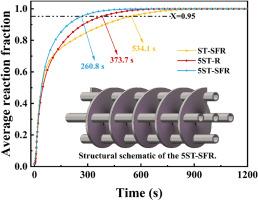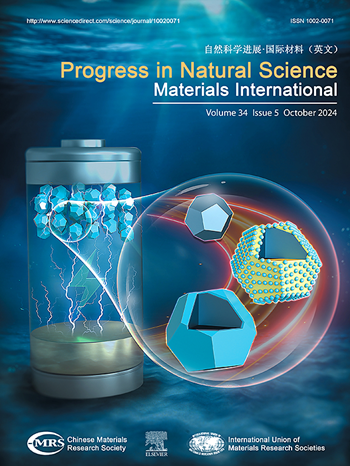通过优化镁基合金储氢反应器的结构和操作参数,显著提高了储氢性能
IF 7.1
2区 材料科学
Q2 MATERIALS SCIENCE, MULTIDISCIPLINARY
Progress in Natural Science: Materials International
Pub Date : 2025-08-01
DOI:10.1016/j.pnsc.2025.06.007
引用次数: 0
摘要
金属氢化物(MH)反应器是工业规模氢储存和运输的关键部件,具有高容量氢储存密度和安全性等优点。然而,大型储罐的应用受到氢吸收过程中产生的大量热量的限制。研究了Mg92Ni4La1Mn3合金的热力学和动力学性质。建立了采用换热管和换翅片对镁基MH反应器吸氢性能进行优化的模型。这种方法显著提高了氢吸收动力学。直管+螺旋翅片反应器(ST-SFR)具有优异的吸氢性能和传热效率。以5直管反应器(5ST-R)为基础,设计了5直管+螺旋翅片反应器(5ST-SFR)的三维模型,采用5根换热管和螺旋翅片进行高效换热。通过仿真分析,确定了最佳运行参数:供氢压力2.0 MPa,初始温度513 K, HTF流速2.0 m/s。与5ST-R相比,5ST-SFR将达到95%吸氢所需的时间(t95% = 260.3 s)缩短了27.5%,所需的HTF质量流率降低了47.6%。建立的数学模型和反应器结构设计为大型镁基MH反应器的研制和利用提供了技术支持。本文章由计算机程序翻译,如有差异,请以英文原文为准。

Significant enhancement of hydrogen absorption performance by optimizing structure and operating parameters in magnesium-based alloy hydrogen storage reactors
Metal hydride (MH) reactors are key components in industrial-scale storage and transport of hydrogen, offering benefits such as high volumetric hydrogen storage density and safety. However, the application of large-scale tanks is constrained by the significant heat generated during hydrogen absorption. This study investigates the thermodynamic and kinetic properties of the Mg92Ni4La1Mn3 alloy. A model is developed to optimize the hydrogen absorption performance of the Mg-based MH reactor by incorporating heat exchange tubes and fins. This approach significantly enhances hydrogen absorption kinetics. The Straight tube + Spiral fins reactor (ST-SFR) shows excellent hydrogen absorption performance as well as heat transfer efficiency. Based on the 5 Straight tube reactor (5ST-R), a three-dimensional model of 5 Straight tube + Spiral fin reactor (5ST-SFR) is designed, incorporating five heat exchange tubes and spiral fins to facilitate efficient heat transfer. Through simulation and analysis, the optimal operating parameters are determined: hydrogen supply pressure of 2.0 MPa, initial temperature of 513 K, and HTF flow velocity of 2.0 m/s. Compared to the 5ST-R, the 5ST-SFR reduces the time required to reach 95 % hydrogen absorption (t95 % = 260.3 s) by 27.5 % and decreases the required HTF mass flow rate by 47.6 %. The established mathematical model and reactor structure design provide technical support for the advancement and utilization of large-scale Mg-based MH reactors.
求助全文
通过发布文献求助,成功后即可免费获取论文全文。
去求助
来源期刊
CiteScore
8.60
自引率
2.10%
发文量
2812
审稿时长
49 days
期刊介绍:
Progress in Natural Science: Materials International provides scientists and engineers throughout the world with a central vehicle for the exchange and dissemination of basic theoretical studies and applied research of advanced materials. The emphasis is placed on original research, both analytical and experimental, which is of permanent interest to engineers and scientists, covering all aspects of new materials and technologies, such as, energy and environmental materials; advanced structural materials; advanced transportation materials, functional and electronic materials; nano-scale and amorphous materials; health and biological materials; materials modeling and simulation; materials characterization; and so on. The latest research achievements and innovative papers in basic theoretical studies and applied research of material science will be carefully selected and promptly reported. Thus, the aim of this Journal is to serve the global materials science and technology community with the latest research findings.
As a service to readers, an international bibliography of recent publications in advanced materials is published bimonthly.

 求助内容:
求助内容: 应助结果提醒方式:
应助结果提醒方式:


